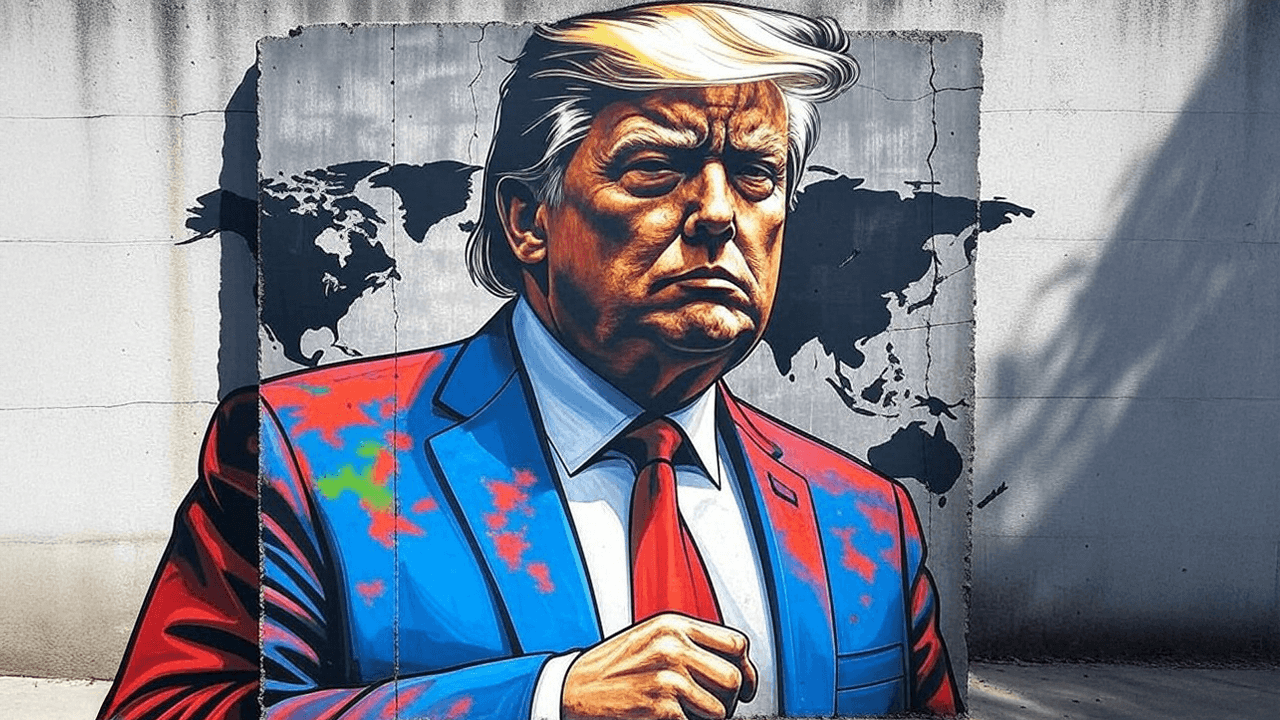
Bill Barhydt, founder and CEO of Abra Global, a crypto asset manager, is projecting that Bitcoin ( BTC ) will likely rally by nearly 70% by summer 2025. Barhydt’s prediction that Bitcoin will trade between $130,000 and $140,000 by mid-summary is rooted in macroeconomic analysis and rising global liquidity, which he views as a major catalyst for the next leg up in crypto markets. In an X post on April 10, Barhydt stated that Bitcoin’s price is closely tied to the broader tech sector and, more importantly, to the global money supply. As central banks inject liquidity into the system, risk assets like Bitcoin and tech stocks tend to rise. Barhydt sees altcoins as leveraged plays on Bitcoin, which mirrors tech equities in liquidity-driven bull cycles. Generally, as money supply grows, investors flock to Bitcoin as a store of value and high-yield opportunity. “Altcoins are going to be a levered bet on Bitcoin. Bitcoin is is a levered bet on tech stocks, and all of it is going up into the right. We’re seeing a very significant increase in global money supply back to where we were end of December and beyond. And that tells me that we should be at new highs for Bitcoin. New highs by midsummer at the latest, probably something in the $130,000 to $140,000 range,” he said. Alongside Bitcoin, the expert is particularly bullish on layer-1 blockchain platforms like Solana ( SOL ), Sui ( SUI ), and Aptos ( APT ). In his view, these assets offer high-beta opportunities that may surpass Bitcoin’s performance in the next rally. Conversely, Barhydt expressed skepticism of meme coins, warning investors to approach them cautiously. He maintained that such assets are likely to trend toward zero over time and should be treated solely as speculative plays. Impact of M2 money supply on Bitcoin’s price According to data from CounterFlow , the M2 money supply across the top 21 central banks currently sits at $108 trillion, growing at a year-over-year rate of 3.79%, its fastest pace since 2022. M2 global supply growth and Bitcoin price chart. Source: CounterFlow Historically, Bitcoin’s price has strongly correlated with expansions in global money supply. During periods of aggressive monetary easing, such as in 2020 to 2021, BTC posted massive gains. Conversely, major drawdowns have often occurred during contractions or stagnation in M2 growth. Aligning with Barhydt’s prediction, Finbold reported that prominent crypto trading expert TradingShot expects the influx of liquidity to push Bitcoin as high as $150,000 by late 2025. Meanwhile, cryptocurrency analyst Lofty noted in an April 11 X post that the “Golden Bull Run” begins April 14, as the Global Liquidity Index turns bullish for the first time since 2021. He forecasts that Bitcoin could eventually hit $350,000. Global liquidity index chart. Source: Lofty Bitcoin price analysis As of press time, Bitcoin is trading at $84,440, up 2.5% in the last 24 hours and 1.8% over the past week. Bitcoin seven-day price chart. Source: Finbold The key focus now is to reclaim the $85,000 resistance zone, which could open the path to clinching the $90,000 level next. Featured image via Shutterstock The post Top crypto asset manager sets Bitcoin’s price target for summer 2025 appeared first on Finbold .
Finbold
You can visit the page to read the article.
Source: Finbold
Disclaimer: The opinion expressed here is not investment advice – it is provided for informational purposes only. It does not necessarily reflect the opinion of BitMaden. Every investment and all trading involves risk, so you should always perform your own research prior to making decisions. We do not recommend investing money you cannot afford to lose.
Crypto’s Biggest Barrier to Adoption? It’s Not Regulation — It’s UX

As the crypto industry matures, much of the focus remains on regulation, custody, and scalability. But in 2025, the biggest barrier to adoption isn’t policy — it’s user experience. Crypto’s interfaces are still too complex for everyday users. From managing seed phrases to deciphering blockchain transactions, onboarding feels more like navigating a maze than joining a financial revolution. Wallets remain fragmented, unintuitive, and risky. To reach mainstream adoption, the industry must prioritize usability — making wallets and financial tools more accessible — without compromising the core principles of decentralization. Until then, poor UX will continue to hold crypto back. Vitalik Buterin’s Call for Account Abstraction Ethereum co-founder Vitalik Buterin has been one of the most vocal proponents for improving the usability of crypto wallets. His critique centers on the fact that wallets are designed with developers, not end-users, in mind. While technical innovations in blockchain security are advancing, wallets often remain rooted in outdated models that prioritize control over ease of use, leaving the average user overwhelmed and vulnerable to mistakes. Buterin’s proposed solution (EIP-7702), account abstraction, is a breakthrough concept that could reshape how we interact with crypto assets. Account abstraction allows smart contract functionality to be applied to externally owned accounts (EOAs), the most common type of wallet used in crypto. This would enable more intuitive and flexible security mechanisms, such as social recovery, multi-signature support, and customizable authentication methods, without compromising decentralization or self-custody. At its core, account abstraction decouples the traditional reliance on a single private key for securing assets, creating the potential for much more user-friendly experiences. Rather than expecting users to memorize long and complex seed phrases or manage multi-step transactions, account abstraction can allow for recovery options, automatic transaction approvals, and even the option to delegate certain actions to trusted contacts — without ever losing ownership of the private keys. A Call for Human-Centered Design in Crypto Crypto’s UX problem isn’t just about cleaner interfaces — it’s about rethinking design to prioritize human needs. Historically, tools have been built for power users comfortable with seed phrases and command-line interfaces. But for mass adoption, crypto must serve people who’ve never held a private key. This is where human-centered design becomes essential. Developers must build wallets and tools that are intuitive, context-aware, and focused on user safety. The shift must move from catering to the technically inclined to empowering everyday users who are new to crypto. To succeed, wallets need to embrace the following core design principles: Smart Defaults and Progressive Onboarding: Users should not need to dive into settings or security configurations to get started. Newcomers should be able to start using a wallet with minimal friction, but with built-in guidance and the option to unlock more advanced features as they become more familiar with the space. By providing clear default security settings — such as social recovery options and automatic transaction limits — wallets can offer both ease of use and security from the outset. Clear, Intuitive Signing Processes: Transaction signing should be straightforward, with clear explanations of what users are agreeing to. If a user is about to approve a transaction that could drain their wallet, this should be prominently displayed in plain language, not buried under hexadecimal codes or complex jargon. Reducing ambiguity in these interactions will help mitigate the risks of scams and human error. Social and Multi-party Recovery Systems: Relying solely on seed phrases as a recovery method is an outdated and risky practice. Instead, wallets should adopt social recovery systems, where users can designate trusted parties to help restore access to their wallet in case of lost keys. This approach not only makes wallets more resilient but also adds a layer of user trust and security. Built-In Education and Contextual Help: To truly empower users, crypto wallets need to include educational tools directly within the interface. Contextual prompts, tooltips, and interactive tutorials can help users understand the significance of each action they take, without overwhelming them with dense technical documentation. Automation with Control: Features like auto-payment for transaction fees or the ability to batch transactions can make using crypto wallets much more intuitive, especially for newcomers. But these features must be balanced with user control. Users should have the final say over transactions, but automation can help reduce some of the cognitive load that crypto novices experience. The Future of Crypto Is Usability and Security—Without Compromise As crypto moves forward, the real challenge will be to reconcile usability with the core tenets of decentralization and security. Innovations like account abstraction are promising, but the industry must continue to prioritize human-centered design. The goal should be to design tools that make crypto accessible, secure, and simple — without sacrificing self-custody or decentralization. The future of crypto will not be determined by how fast blockchains can scale or how complex DeFi protocols can get; it will be defined by whether the average person can use crypto with confidence. Until then, crypto will remain an exclusive tool for developers and enthusiasts, rather than a technology that empowers the masses. The question is simple: Can crypto be both intuitive and secure, or will it continue to be a space designed only for the technically proficient? The answer will determine whether crypto achieves its promise of financial freedom for all. Finbold

Toncoin May Be Positioned for a Short-Term Rebound as Bullish Signals Emerge
Toncoin (TON) is showing promising signs of a bullish reversal, following significant on-chain and technical indicators. The recent uptick in investor activity suggests a growing confidence amidst a challenging market Finbold











